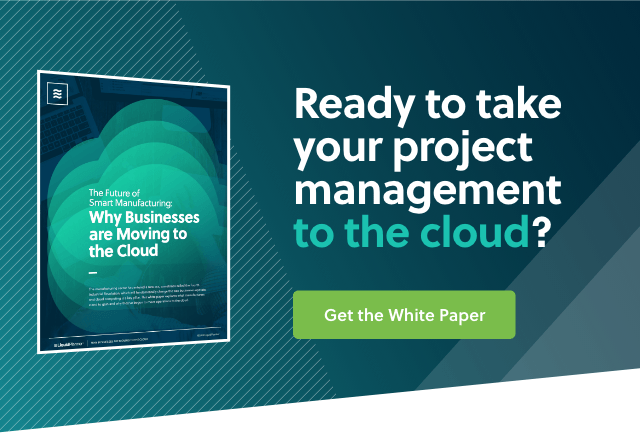The title of this article, ‘Why Manufacturers are Switching to the Cloud’, can be unpacked into two questions:
1) Are manufacturers switching to the cloud?
2) And if so… why?
The answer to the first question is clearly, absolutely, and definitely yes—the 2017 State of Manufacturing Technology, an annual report, says that, “90% of respondents are using cloud-based productivity applications, double the number in 2016.” In fact, manufacturers are moving to the cloud so quickly that some are referring to the change as the Fourth Industrial Revolution.
Now a Fourth Industrial Revolution is building on the Third, the digital revolution that has been occurring since the middle of the last century. It is characterized by a fusion of technologies that is blurring the lines between the physical, digital, and biological spheres… When compared with previous industrial revolutions, the Fourth is evolving at an exponential rather than a linear pace.
But this very rapidity of adoption points to something a bit unusual about cloud use by manufacturers; in this arena, manufacturing (like AEC) has lagged behind other sectors, and is now playing ‘catch up’.
Until recently, the industry has struggled to adopt cloud computing technologies outside of the relative simple Infrastructure-as-a-Service (IaaS) platforms that are available, because the cost of “moving to the cloud” has often been regarded as too high, or because of perceived security threats. (Scale or fail: Manufacturing companies must leverage cloud and interconnection, Data Centre News, Nov. 9, 2017)
Of course, the reluctance of manufacturers to move to the cloud is not due to a general suspicion of technology—of all sectors, manufacturing has made the most efficiency gains in recent decades by adopting digital technology. Rather, cloud-based services specifically are perceived as a challenge, for a variety of reasons that fall under two main headings.
Security
As mentioned above, “perceived security threats” of the cloud are a major reason for lagging adoption by manufacturers. A report by Jon Peddie Research (CAD in the Cloud) provides interesting insight on this issue.
“This should not come as a surprise,” says Jon Peddie Analyst Kathleen Maher in an article on the report. “CAD customers are very protective of their data, and they are security conscious, but most of all, they are not a monolithic group.” She adds, “We also think that the past few years, which have been punctuated every few months with major security breaches, have confirmed many people’s misgivings about the security of cloud-based applications.”
Still, this perception is being overcome. Maher says:
“The study also found that workers in manufacturing fields were more likely to be adding CiC (CAD in Cloud) capabilities to their workflow than those in AEC. We have some thoughts about why this might be. The manufacturing industry is more advanced in its CAD use, having moved to extensive data management (including PLM) for more than a decade before the AEC industry, and PLM almost necessarily requires centralized data access, for which the cloud is ideal.” (emphasis added)
And in connection with the security breaches discussed above, Maher says, “We won’t go into the arguments that say cloud-based workflows might be safer than traditional methods, other than to point out that most of the breaches have not happened in applications using cloud resources such as SaaS or servers-as-a-service, but rather in companies relying on traditional—and often out-of-date—systems.” (emphasis added)
In other words, concerns about cloud security are fading as manufacturers begin to leverage their already extensive knowledge of digital data management, and as services specifically designed for the cloud—as opposed to ad hoc extensions of existing solutions—begin to emerge.
Productivity
Manufacturers also worry that productivity will take a hit if some—not all—processes move to the cloud. Maher says, “We’re not particularly surprised that so many respondents were not interested in CiC. The cloud has yet to prove itself as a hospitable environment for design. At this point, it is more useful for collaboration, design validation, and document management than design itself, and the report bears this out.” (emphasis added)
Much of this productivity hit comes down to latency (or lag), that is, the tendency of Internet speeds and bandwidth to drop unpredictably and slow down cloud-based applications. Latency remains a challenge for CAD work and, by extension, CAM, SCADA, and other traditional ‘shop floor’ processes.
But it’s not necessarily a problem for other manufacturing processes. “A certain amount of latency can be tolerated and maybe not even noticed in data management,” says Maher.
“People send off data for processing and their machine is freed up for other work.” Plus, cloud-based solutions for project management, EPM, PLM, and other data management/processing tasks can take advantage of connectivity, realtime updating, automated monitoring, and all the other major selling points of the cloud.
It’s not really accurate to say that manufacturers have been slow to adopt cloud-based solutions. Rather, their move to the cloud has been nuanced, recognizing that cloud-based applications are not (yet) appropriate in some areas, like design, and that more secure solutions were being developed for processes like project management.
Many manufacturers are finding ways to make use of mature cloud capabilities now by using a hybrid approach. “While businesses of all types make a steady march to the cloud, manufacturers are pursuing a hybrid strategy, opting to retain some foundational plant-floor systems on premise while earmarking analytics and production applications for migration to the new environment.” (Manufacturers’ Slow, but Steady Migration to the Cloud, Automation World, May 10, 2017) (emphasis added)
Part two of this series addresses why manufacturers are moving to the cloud. But for manufacturers wondering just how to begin taking advantage of cloud computing’s many strengths, this hybrid approach offers an obvious way forward; continue, for now, with existing on-premise solutions for design and traditional shop floor processes, while aggressively adopting cloud-based solutions for ‘data forward’ processes like project management. Read part two now.








